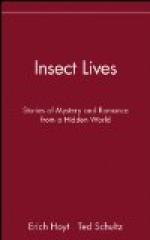[Illustration: Fig. 6. Apple Aphid (Aphis pomi), virgin females, a, wingless; b, winged. Magnified 20 times.]
A family of Hemiptera, related to the Aphidae and equally obnoxious to the gardener, is that of the Coccidae or scale-insects. These furnish an excellent illustration of features noticeable in certain insect life-histories. In the first place, the newly-hatched young differs markedly from the parent in the details of its structure. A young coccid (fig. 7 c) is flattened oval in shape, has well-developed feelers (fig. 7 d) and legs, and runs actively about, usually on the leaves or bark of trees and shrubs, through which it pierces with its long jaws, so that it may suck sap from the soft tissues beneath. After a time it fixes itself by means of these jaws and the characteristic scale or protective covering, composed partly of a waxy secretion and partly of dried excrement, begins to grow over its body. The female loses legs and feelers, and never acquires wings, becoming little more than a sluggish egg-bag (fig. 7 e). The male on the other hand passes into a second larval stage in which there are no functional legs, but rudiments of legs and of wings are present on the epidermis beneath the cuticle, as shown by B.O. Schmidt for Aspidiotus (1885). The penultimate instar of this sex in which the wing-rudiments are visible externally lies passively beneath the scale, its behaviour resembling that of a butterfly pupa. The adult winged male (fig. 7 a) leads a short, but active life.
[Illustration: Fig. 7. Mussel Scale-insect (Mytilaspis pomorum). a, male; b, foot of male; c, larva, ventral view; d, feeler of larva; e, female, ventral view. After Howard, Yearbook U.S. Dept. Agric. 1904. Magnified, a, c, e x 20; b, d x 120.]
Another family allied to the Aphidae is that of the Cicads, hardly represented in our fauna but abundant in many of the warmer regions of the earth. Here also the young insect differs widely from its parent in form, living underground and being provided with strong fore-legs for digging in the soil. After a long subterranean existence, usually extending over several years, the insect attains the penultimate stage of its life-story, during which it rests passively within an earthen cell, awaiting the final moult, which will usher in its winged and perfect state.
In the life-histories of cicads and coccids, then, there are some features which recall those of the caterpillar’s transformation into the butterfly. The newly-hatched insect is externally so unlike its parent that it may be styled a larva. The penultimate instar is quiescent and does not feed. But while the caterpillar shows throughout its life no outward trace of wings, external wing-rudiments are evident in the young stages of the cicad. In the male coccid we find a late larval stage with hidden wing-rudiments, the importance of which, for comparison with the caterpillar, will be appreciated later.




